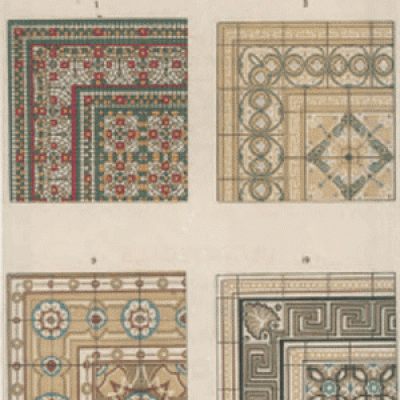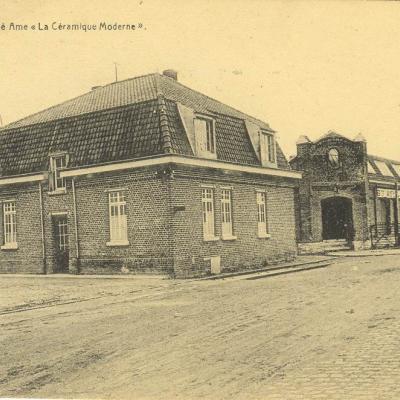A small, c.4.5m2, antique Rebaix ceramic, early 20th century
One of two floors reclaimed from the same property close to Orbais in Belgium, a small 4.6m2 / 49.5 sq ft ceramic encaustic tile with its original borders, one full size, one half size. The principal field and large border are 14cm sq and the half size 14cm x 7cm. The border configuration is of a small, large, and small border, so a triple border tile lay framing the field tile. All border corner tiles have been reclaimed, four for the large, eight for the small.
The tiles were manufactured by Societe Anonyme Ceramiques Modernes Rebaix and we would date them as c.1920-1930. In the photo gallery we have included a scan from the page in their period catalogue and the half sized border can be seen in the top right corner. Indeed. the other floor taken from the same house is the field tile and large border tile in that panel and those tiles are reverse stamped ‘R’. A link to the other floor can be found here
The tiles have cleaned well, as a high-resolution section of them in the gallery display. Small edge nibbles and groutable small chips are evident on an excellent ceramic 15mm thick. The palette is cool in shades of grey and white and the electric blue in the field and border tile detail is especially vibrant.
Tile quantities, give or take one or two:-
FIELD tiles – 115 – 2.3m2 / 24.7 sq ft.
LARGE BORDER tiles – 53 plus 4 corners – 1.1m2 / 12.3 sq ft. – 8 linear metres / 26.2 linear ft.
SMALL BORDER tiles – 120 plus 8 corners – 1.24m2 / 13.3 sq ft. – 17 linear metres / 55.8 linear ft.
NOTE:-
Antique tiles were most commonly made in single or two tile moulds. Before current computer automation methods their moulds were made my hand and the colour slips mixed by eye. Kiln temperatures could also be variable, as could the firing time. The result is that often tiles display subtle size and thickness variations and there can be tonal variations in colours, owing to the slip mixing and/or firing time. All of this makes these handmade tiles unique and adds to their charm. Some floors display their subtle variations in size and tones, some not, but when photographing we always take a random section of the floor so that it is representative of the whole. A tiler should always dry lay a section of the tiles to familiarise himself with them before starting to fix lay.
CL150






